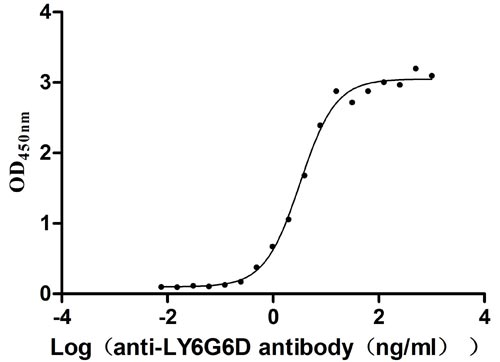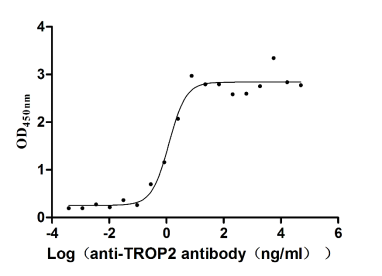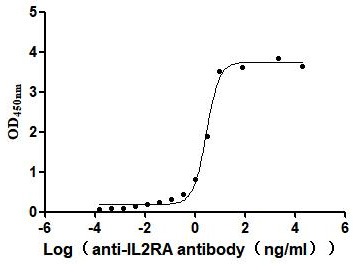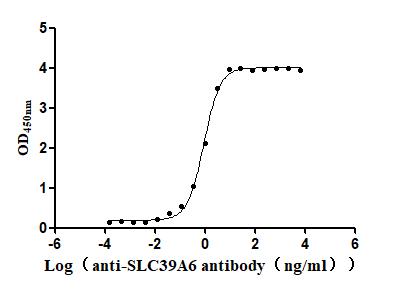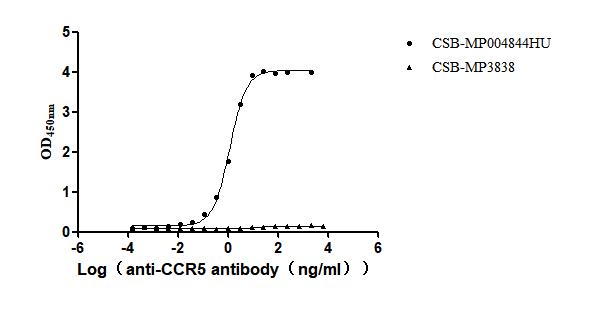Recombinant Human Nuclear migration protein nudC (NUDC)
-
中文名稱:
-
貨號:CSB-EP016148HU-B
-
說明書:
-
規格:
-
來源:E.coli
-
共軛:Avi-tag Biotinylated
E. coli biotin ligase (BirA) is highly specific in covalently attaching biotin to the 15 amino acid AviTag peptide. This recombinant protein was biotinylated in vivo by AviTag-BirA technology, which method is BriA catalyzes amide linkage between the biotin and the specific lysine of the AviTag.
-
其他:
產品詳情
-
純度:>85% (SDS-PAGE)
-
基因名:NUDC
-
Uniprot No.:
-
別名:Nuclear migration protein nudC; Nuclear distribution protein C homolog; NUDC
-
種屬:Homo sapiens (Human)
-
蛋白標簽:Tag?type?will?be?determined?during?the?manufacturing?process.
The tag type will be determined during production process. If you have specified tag type, please tell us and we will develop the specified tag preferentially. -
產品提供形式:Liquid or Lyophilized powder Warning: in_array() expects parameter 2 to be array, null given in /www/web/cusabio_cn/public_html/caches/caches_template/default/content/show_product_protein.php on line 662
Note: We will preferentially ship the format that we have in stock, however, if you have any special requirement for the format, please remark your requirement when placing the order, we will prepare according to your demand. -
復溶:We recommend that this vial be briefly centrifuged prior to opening to bring the contents to the bottom. Please reconstitute protein in deionized sterile water to a concentration of 0.1-1.0 mg/mL.We recommend to add 5-50% of glycerol (final concentration) and aliquot for long-term storage at -20℃/-80℃. Our default final concentration of glycerol is 50%. Customers could use it as reference.
-
儲存條件:Store at -20°C/-80°C upon receipt, aliquoting is necessary for mutiple use. Avoid repeated freeze-thaw cycles.
-
保質期:The shelf life is related to many factors, storage state, buffer ingredients, storage temperature and the stability of the protein itself.
Generally, the shelf life of liquid form is 6 months at -20°C/-80°C. The shelf life of lyophilized form is 12 months at -20°C/-80°C. -
貨期:Delivery time may differ from different purchasing way or location, please kindly consult your local distributors for specific delivery time.Note: All of our proteins are default shipped with normal blue ice packs, if you request to ship with dry ice, please communicate with us in advance and extra fees will be charged.
-
注意事項:Repeated freezing and thawing is not recommended. Store working aliquots at 4°C for up to one week.
-
Datasheet :Please contact us to get it.
相關產品
靶點詳情
-
功能:Plays a role in neurogenesis and neuronal migration. Necessary for correct formation of mitotic spindles and chromosome separation during mitosis. Necessary for cytokinesis and cell proliferation.
-
基因功能參考文獻:
- High expression of NUDC is associated with prostate cancer. PMID: 27959429
- the upregulation of miR-194 affects the hNUDC expression, leading to a downregulated expression of Mpl/ERK pathway proteins, and suppresses the mitosis and proliferation of NSCLC cells. PMID: 27035759
- NudC is co-localized with Aurora B at the midbody and co-immunoprecipitated with Aurora B in mitosis. results suggest that that dynamic phosphorylation of NudC by Aurora B regulates cytokinesis. PMID: 27074040
- NudC acetylation/deacetylation regulates mitotic progression and NudC deacetylation, likely through HDAC3, is critical for spindle function and chromosome congression. PMID: 24069238
- Human nuclear distribution C is found to be closely associated with cell malignant hyperplasia in nasopharyngeal carcinoma. PMID: 21473139
- NudC may be involved in the regulation of LIS1 stability by its chaperone function. PMID: 20675372
- separate binding sites on the Mpl receptor for TPO and hNUDC identified PMID: 20529857
- Mpl plays an important and specific role in mediating hNUDC-induced megakaryocyte proliferation and differentiation. PMID: 19560457
- functions in mitosis and cytokinesis, in part by regulating microtubule organization at the midzone and midbody PMID: 12679384
- PLK1 phosphorylation of NudC plays an essential role in cytokinesis. PMID: 12852857
- Overexpression of NUDC inhibits prostatic neoplasm growth. PMID: 14676831
- In this study, we report the binding of hNUDC to the extracellular domain of the thrombopoietin receptor (Mpl) as detected by the yeast two-hybrid system, GST pull-down, and co-immunoprecipitation. PMID: 16088917
- NudC functions as both a substrate and a spatial regulator of Plk1 at the kinetochore to promote chromosome congression. PMID: 16860740
- hNUDC induced significant changes in cellular morphology in NIH 3T3 cells stably transfected with pMpl-EGFP. Interestingly, these morphological changes were characteristic of cells undergoing megakaryocyte differentiation. PMID: 17658515
- hNUDC induced a sustained activation of the extracellular signal-regulated protein kinases-1 and -2 (ERK1/2) as well as p38 mitogen-activated kinase (p38 MAPK) pathways PMID: 18288130
顯示更多
收起更多
-
亞細胞定位:Cytoplasm, cytoskeleton. Nucleus. Cytoplasm, cytoskeleton, spindle. Midbody.
-
蛋白家族:NudC family
-
組織特異性:Ubiquitous. Highly expressed in fetal liver, kidney, lung and brain. Highly expressed in adult pancreas, kidney, skeletal muscle, liver, lung, placenta, prostate, brain and heart.
-
數據庫鏈接:
Most popular with customers
-
Recombinant Human Claudin-4 (CLDN4)-VLPs (Active)
Express system: Mammalian cell
Species: Homo sapiens (Human)
-
Recombinant Human Lymphocyte antigen 6 complex locus protein G6d (LY6G6D) (Active)
Express system: Yeast
Species: Homo sapiens (Human)
-
Recombinant Human Tumor-associated calcium signal transducer 2 (TACSTD2), partial (Active)
Express system: Mammalian cell
Species: Homo sapiens (Human)
-
Recombinant Human Interleukin-2 receptor subunit alpha (IL2RA), partial (Active)
Express system: Mammalian cell
Species: Homo sapiens (Human)
-
Recombinant Macaca fascicularis Zinc transporter ZIP6 isoform X1(SLC39A6),partial (Active)
Express system: Baculovirus
Species: Macaca fascicularis (Crab-eating macaque) (Cynomolgus monkey)
-
Recombinant Human C-C chemokine receptor type 5 (CCR5)-VLPs (Active)
Express system: Mammalian cell
Species: Homo sapiens (Human)



